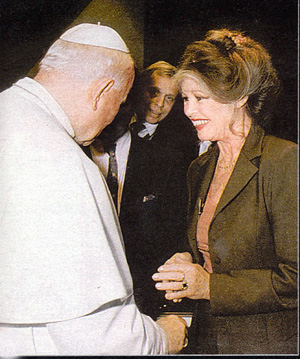 |
NEWS: March 15, 2003
Bird’s Eye View of the News
Atila Sinke Guimarães
PAPAL POETRY – A booklet of poetry by John Paul II entitled Roman Triptych was recently released in Polish (40 pages including reproductions of Michelangelo’s pictures). The work is planned to be published in other languages by Libreria Editrice Vaticana (Vatican Publishing House). In the meantime, Zenit News Agency (March 7), duly authorized by the Vatican, provided part two of the three-part poetry.
Part two, entitled "At the Threshold of the Sistine Chapel," is a reflection on Genesis. Its message is supposed to be sublime, closed to an easy understanding. Even if the message were not sublime, the tactic is intelligent, since it implicitly accuses all the readers who do not understand it of being simple-minded unless they acknowledge its sublimity.
Someone is sure to object: You should not make such a criticism! It shows a lack of respect for the Pope. I answer: No, this is not true. Since the subject of the work is a disputable personal interpretation of philosophy and art, it does not imply any need for the adherance of Catholics. Therefore, he chose to set aside his papal dignity and assume the role of a simple writer. I am analyzing him as such.

John Paul II has accepted nudity not only in theory. Here he just received the Offertory gifts from this very poorly clad woman. Papua New Guinea, May 8 1984 - Photo Felici, Rome

JPII receives Brigitte Bardot. She was famous for being the first popular movie star to appear completely nude in the 1956 French film "And God created Woman" - Corriere della Sera, Sept. 28, 1995

Card. Wojtyla (with a red bandanna) shows his limbs and enjoys the company of other scantily clothed friends on an overnight camping trip in the Polish woods - Oggi, January 26, 1979
|
In this text, Wojtyla intends to give a key for understanding creation, history (past, present and future), art, and also the Vatican philosophical-theological diplomatic and pastoral framework. He is not modest in his goal…
Reading his text, I recognized the same thesis underlying many speeches that he gave some years ago on the Theology of the Body, and also in significant parts of his Apostolic Letter Mulieris dignitatem. Is there a key to understand Wojtyla’s rather obscure key? There is, and I will try to present it in a clear way.
For this personalist Pope, everything relies on the realization of the person, following the steps of Max Scheler. According to this conception, “I” only encounter myself in the “you,” id est, in the disinterested attempt to “realize” the other person I love. And vice-versa, the “you” would only fulfill his personality seeking to realize my “I.” The achievement of the binomial I-You, is the molecule, the fundamental unit of this new philosophical approach that would explain human psychology, the constitution of society, and history. The base is no longer the fulfillment of the individual contingent being in the Absolute, which is God, as was always taught in Catholic Philosophy.
During his pontificate John Paul II has often applied this notion to the interpretation of Genesis in an attempt to give citizenship to a “personalist theology.” How would it apply to creation? The key phrase is that when God created man and woman, in the beginning “male and female He created them." Let us leave aside here any androgynous interpretations that hastily suppose both sexes in the original man. If someone would attribute to JPII these interpretations, it could be embarrassing for him, since we would have the Pope defending a thesis very close to some notions presented in the Kabala. For the moment, let us stay just with the notion of the “realization of the person.”
Then, God would have created man and woman in a way that the former would only be “realized” in the latter and vice-versa. This would be the description of the original happiness. In his poetry this “self-giving” is the key for happiness:
“God graciously gave them a gift.
They received in themselves in a human way the mutual self-giving
which is Him.”
But then Adam did something wrong. He tried to realize himself individually rather than “personally.” This would be bad because he turned to self-realization instead of the realization of the “you.” That is to say, Adam took pleasure in affirming his masculine characteristics: dominium, power, and strength. Doing that he broke the first equilibrium of the I-You binomial. And this would have been the original sin. Redemption for this sin would be for man to renounce any self-realization, any dominion, power or strength. This paragraph is not in the poetry, but in Mulieris dignitatem (7a,b,e,g; 10a; 11d,e) and in some general audiences he gave on the Theology of the Body (October 10 and 31, 1979; April 30, 1980; May 14, 1980; June 18, 1980; January 13, 1982; October 6, 1982).
Is the sexual relation a good thing? Yes, to the measure that the “I” tries to fulfill the “you” of the other. You can see what kind of possibilities this opens up for progressivists who would like to abandon perennial Catholic Morals. For the sake of decency I will set aside the details from other of Wojtyla’s writings and quote here only from the poetry:
“And then they become one body
that marvelous union
beyond which fatherhood and motherhood are revealed.
Then they touch the fountain of life that is in them.
They reach to the Beginning.”
Is nudity bad? Not in itself. Only to the self-interested mind of a man or women who looks at a nude person with bad intentions. In the second part of John Paul II’s poetry he praises nudity nine times directly and four times indirectly. I will divide them into groups:
First, he praises the nudity of Adam and Eve before the sin. Since nudity is approved in Genesis, there is no problem.
Second, he praises the nudity of the figures painted by Michelangelo in the Sistine Chapel, which is much more disputable from a moral point of view. In fact, fourteen years after they were painted, Pope Paul IV commanded that some indispensable clothing be painted over Michelangelo's nudes.
However, according to John Paul II:
“We are standing at the threshold of the Book [of Genesis with the naked couple].”
Further he states:
“Naked they were and did not feel shame.
Was it possible?
Do not ask those who are contemporary, but Michelangelo
(and perhaps the contemporary as well?)
Ask the Sistine.”
Therefore, he implies that after the original sin there would still be a way to be naked without moral problems. How? By applying the personalist key of self-donation: If you are nude without malice or you look at a nude person or her/his picture just to enjoy the beauty of the body, it would be fine, according to the Wojtylian morals.
Third, he praises nudity per se when he states:
“Both naked…
they felt no shame,
as long as the gift lasted.
Shame will come together with sin,
but even then the elation will remain.
They live conscious of the gift,
though they not know its name.”
Again, according to Wojtyla, there would be a good way to be naked after original sin.
Fourth, after some sublime words meditating upon his own death and the gathering of a new conclave to elect his successor, he once again returns to the mystery of the “good” nudity in a counsel to the Cardinals:
“Do not forget: Omnia nuda et aperta sunt ante oculos Eius
[Before the eyes of God everything appears nude and opened]. You who are in all, show the way!
He will teach you…”
I sincerely hope that with regard to clothing, the Cardinals at the next conclave will not follow the general lines of this poetry too literally and will not try to reproduce in their meetings on the floor of the Sistine Chapel scenes analogous to those painted on its ceiling.
This, then, is my suggestion to an easier understanding of Wojtyla’s poetry.
There is a curious by-product from this piece. The phrase “Everything endures continually becoming” (1st verse, 7th line) seems to confirm the old evolutionist convictions defended by Karol Wojtyla in some of his books before he was elected Pope. Also the phrase “The universe emerged from the Word, and returns to the Word” (3rd verse, "Fulfillment Apocalypisis," 2nd line) is open to an evolutionist interpretation. Actually, the universe did not “emerge” from God, but was “created” by God with no confusion of substances. Again, a hint of evolutionism.
A change in the Catholic Philosophy, a change in Catholic Morals, and a change in Catholic Exegesis, these are the fruits that can be harvested from the second part of the Pope’s poetry. Was it worthwhile to write it?

|
News | Home | Books | CDs | Search | Contact Us | Donate

©2002- Tradition in Action, Inc. All Rights Reserved
|
 |
|